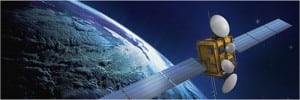Latest News
[Via Satellite 08-29-2014] Commercial weather company GeoMetWatch is reevaluating its original plan to orbit six geo-hyperspectral sounders as hosted payloads. Instead, the company hopes a new approach that includes separate satellites will help to bring the constellation online by 2020.
“We are looking at some free-flyer opportunities which, for some of our potential investors, are much more attractive,” David Crain, president and CTO of GeoMetWatch told Via Satellite. “There is more flexibility on where we can put them into orbit, more flexibility on the way we operate it, we would have the ability to move it around in orbit … we would still probably operate them as a communications satellite, and we would still be teaming with one or more operators to use their spectrum space, but ultimately I am almost certain we will end up having a mix.”
The first of GeoMetWatch’s sounders was originally supposed to fly aboard the AsiaSat 9 satellite, but the company was unable to raise sufficient funding in order to meet the operator’s deadline. Crain said the company originally anticipated financial commitments from AsiaSat or former business partner Utah State University (USU), but received neither.
As these partnerships came apart, USU signed with Tempus Global Data to commercialize the 300-kg Sounding and Tracking Observatory for Regional Meteorology (STORM)-based hosted payloads. GeoMetWatch signed with Exelis to continue the project, and filed a lawsuit against both Tempus Global Data and USU, claiming it was tricked into disclosing extremely valuable trade secrets that have now been stolen.
Exelis anticipates it would take three years to manufacture a geo-hyperspectral sounder, which is now based on the company’s Advanced Baseline Imager (ABI). Crain said GeoMetWatch can still orbit the constellation on time if the first sounder is launched in 2017. Once in Geosynchronous Orbit (GEO), the data provided by GeoMetWatch would increase the number of soundings usable for meteorology by 60 to 100-fold. The company anticipates seeing tangible benefits from the sounders starting with the very first one.
“Originally we thought in order to see benefits we would have to deploy our entire constellation, but several weather agencies around the world have been doing some studies indicating that from a geo-hyperspectral sounder, even if that sounder does not sample your local space it still has a global impact,” said Crain. “If we have a sounder over Asia, the observations that sounder makes actually improve the quality of the forecasts three and five days out over the U.S. and Europe, because all weather is global and all weather is interconnected.”
Crain said GeoMetWatch is currently evaluating two other hosted payload opportunities in lieu of AsiaSat 9, and is working to meet the integration schedules. A third option is emerging too, he said. GeoMetWatch has not determined how many of the geo-hyperspectral sounders will shift from hosted payloads to free-flyers. Exelis is expected to finalize the design for the new sounder this year, at which point GeoMetWatch will make further decisions.
“We have some internal estimates done where, with a fully deployed constellation, we may see three-day forecasts approach the accuracy of today’s one-day forecast,” said Crain. “That would be our goal.”
Though financing has proven difficult, Crain said the number of potential customers has grown significantly since the company started. Rather than focusing primarily on government customers, commercial buyers in industries such as aviation and agriculture are expected to play a bigger part. GeoMetWatch is focusing on creating more end user products as well to further spur on commercial sales. Government, though no longer the anticipated primary customer, is still expected to be a large buyer.
“[For] investors, their biggest risk is: we fly this mission and we have no customer. I try to paint the picture: that’s impossible … we took a requirement that the government said it has to have, but in the end couldn’t fund because of cost overruns with the Joint Polar Satellite System (JPSS) and the Geostationary Operational Environmental Satellite R-Series (GOES-R). The requirement for the data of this type is still there.”
In addition to cost overruns, one of the reasons the U.S. government discontinued the sounder was the massive amount of data it would create. The government feared it would need an entirely new ground system to accommodate the data surge. Now, thanks to Moore’s law, this is no longer believed to be necessary. For GeoMetWatch, the company’s focus remains on identifying the best way to get the sounders in space.
“Some of these missions will fly as hosted payloads because some operators really want the business. They are accommodating; it’s just can we meet their schedule and integration timelines?” he said. “[But] ultimately, in the long run, the majority of these may move to free-fliers.”
Get the latest Via Satellite news!
Subscribe Now